
Concept explainers
(a)
Interpretation:
The root-mean-square speed of
Concept introduction:
The expression to calculate the root-mean-square speed is as follows:
Here,
The kinetic energy is directly proportional to the temperature and inversely proportional to the molar mass.
(a)
Answer to Problem 5.82P
The root-mean-square speed of
Explanation of Solution
The formula to convert
Substitute
The expression to calculate the root-mean-square velocity of
Substitute the value
Substitute
Substitute the value
The root-mean-square speed of
(b)
Interpretation:
The root-mean-square speed of
Concept introduction:
The expression to calculate the root-mean-square speed is as follows:
Here,
The kinetic energy is directly proportional to the temperature and inversely proportional to the molar mass.
The mathematical expression of Graham’s law of effusion is as follows:
Here,
(b)
Answer to Problem 5.82P
The root-mean-square speed of
Explanation of Solution
The formula to convert
Substitute
The expression to calculate the root-mean-square velocity of
Substitute the value
The expression to compare the root-mean-square speed of
Substitute the value
The root-mean-square speed
(c)
Interpretation:
The average kinetic energy of
Concept introduction:
The expression to calculate the average kinetic energy is as follows:
Here,
The kinetic energy is directly proportional to the temperature.
(c)
Answer to Problem 5.82P
The average kinetic energy of
Explanation of Solution
The expression to calculate the average kinetic energy of
Substitute the value
The expression to calculate the average kinetic energy of
Substitute the value
The average kinetic energy of
(d)
Interpretation:
The average kinetic energy per molecule of
Concept introduction:
The expression to calculate the average kinetic energy is as follows:
Here,
The kinetic energy is directly proportional to the temperature.
(d)
Answer to Problem 5.82P
The average kinetic energy per molecule of
Explanation of Solution
The expression to calculate the average kinetic energy of
Rearrange the equation (6) in per molecule by dividing
Substitute the value
The average kinetic energy per molecule of
Want to see more full solutions like this?
Chapter 5 Solutions
EBK CHEMISTRY: THE MOLECULAR NATURE OF
 ChemistryChemistryISBN:9781305957404Author:Steven S. Zumdahl, Susan A. Zumdahl, Donald J. DeCostePublisher:Cengage Learning
ChemistryChemistryISBN:9781305957404Author:Steven S. Zumdahl, Susan A. Zumdahl, Donald J. DeCostePublisher:Cengage Learning ChemistryChemistryISBN:9781259911156Author:Raymond Chang Dr., Jason Overby ProfessorPublisher:McGraw-Hill Education
ChemistryChemistryISBN:9781259911156Author:Raymond Chang Dr., Jason Overby ProfessorPublisher:McGraw-Hill Education Principles of Instrumental AnalysisChemistryISBN:9781305577213Author:Douglas A. Skoog, F. James Holler, Stanley R. CrouchPublisher:Cengage Learning
Principles of Instrumental AnalysisChemistryISBN:9781305577213Author:Douglas A. Skoog, F. James Holler, Stanley R. CrouchPublisher:Cengage Learning Organic ChemistryChemistryISBN:9780078021558Author:Janice Gorzynski Smith Dr.Publisher:McGraw-Hill Education
Organic ChemistryChemistryISBN:9780078021558Author:Janice Gorzynski Smith Dr.Publisher:McGraw-Hill Education Chemistry: Principles and ReactionsChemistryISBN:9781305079373Author:William L. Masterton, Cecile N. HurleyPublisher:Cengage Learning
Chemistry: Principles and ReactionsChemistryISBN:9781305079373Author:William L. Masterton, Cecile N. HurleyPublisher:Cengage Learning Elementary Principles of Chemical Processes, Bind...ChemistryISBN:9781118431221Author:Richard M. Felder, Ronald W. Rousseau, Lisa G. BullardPublisher:WILEY
Elementary Principles of Chemical Processes, Bind...ChemistryISBN:9781118431221Author:Richard M. Felder, Ronald W. Rousseau, Lisa G. BullardPublisher:WILEY





